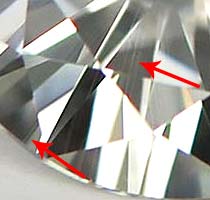Support
Education
Color, Clarity, & Carat
Moissanite Color
Our company offers Moissanites in both colorless and near colorless ranges, and we utilize the color grading scale developed by GIA, commonly used for diamonds, to grade Moissanites:
- Grades D, E, F: colorless
- Grades G, H, I: near coloress
- Grades J, K: faint color
According to this scale, Moissanites with grades D, E, and F are classified as colorless, while grades G, H, and I are categorized as near colorless. Moissanites with grades J and K exhibit a faint yellow hue. It is important to note that grades D, E, F, and even G Moissanites are virtually colorless and can be described as having an "icy" white appearance, while grades H and I exhibit a slightly warmer or steely white hue. As the grading scale progresses into the J and K range, the yellow tint becomes more noticeable.
Moissanite Clarity
Clarity refers to the presence of surface blemishes and internal inclusions in a gemstone. When compared to natural diamonds, Moissanite experts concur that the average clarity of Moissanite is equivalent to VS clarity on the GIA scale. This indicates that inclusions are only visible under magnification and are difficult to discern under a jeweler's loupe with a 10x magnification. It is worth noting that less than 10% of faceted diamonds possess this level of clarity.

Moissanite Carat
The carat is the conventional unit of measurement for a diamond's weight. However, Moissanite is typically not described in terms of its actual carat weight, as it weighs roughly 10% less than a diamond. For instance, a 6.5mm round diamond would weigh 1.0 carat, while a 6.5mm round Moissanite would weigh approximately 0.88 carats. Despite being of the same size, the two stones have different carat weights, which can be confusing. To address this issue, Moissanite measurements are usually listed in millimeters and accompanied by their diamond equivalent weight in carats. This way, a 1-carat round diamond and a 1-carat round Moissanite have the same size. For a comprehensive conversion table of size to diamond equivalent carat weight, please visit our loose stone page.